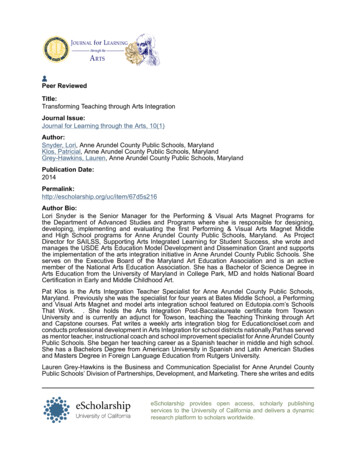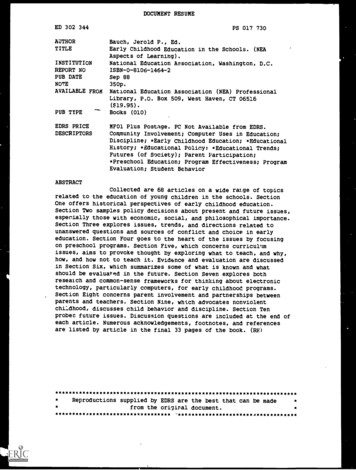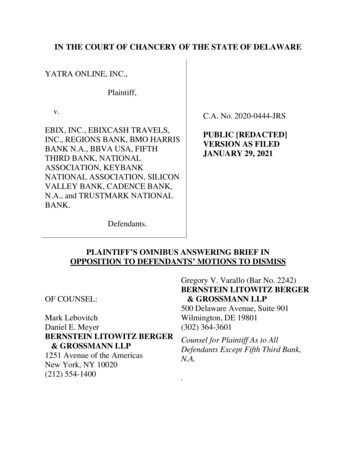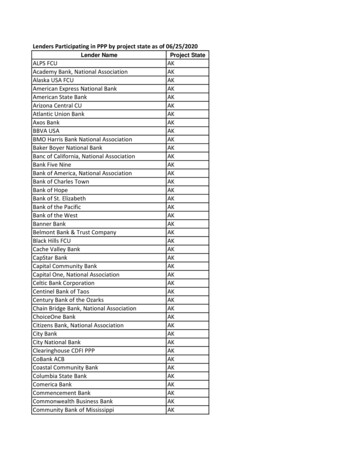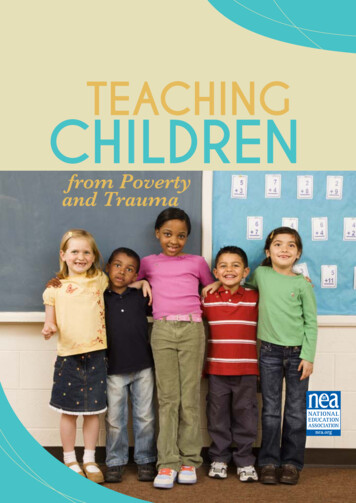
Transcription
2 National Education Association Education Policy and Practice
ContentsIntroduction. 5Section 1. Symptoms. 9Section 2. Risk Factors/Impact. 11Section 3. Research. 17Section 4. Educator Roles.19Section 5. Long-Term Learnings.23Section 6. Actionable Strategies.25Conclusion.34Resources.36
Poverty is a chronic and debilitatingcondition that results from multiple adversesynergistic risk factors and affects themind, body, and soul.”Introduction(Jensen, Teaching, 6)This handbook was created to provide NEA member educators with a research-based description of the impact of poverty on teaching and learning. It is important to understand poverty’s impact on children’s educationalsuccess, along with strategies for overcoming the impact of poverty on the brainand learning.In 2015, according to government standards describing poverty, 51 percentof students in public schools lived in a poverty household. (Jensen, Poor Students, Rich Teaching, 7) Poverty impacts the lives of students by creating emotional and social challenges, acute and chronic stressors, cognitive lags, andhealth and safety issues. These issues include more hazardous places to live,less green space, and contaminated water and air. What does the poverty thatour students come from look like? Poverty is crowded, noisy, physically deteriorating households. There are fewer support networks on which students canrely. Students often rely on peers for social and emotional support. The stressors experienced from poverty traumatize their victims. (Jensen, Teaching, 7-10)In addition, many students from poverty have been traumatized in ways notdirectly related to their socioeconomic status. The number of students living inpoverty who have been traumatized has been estimated between 50-80 percent. Trauma is the unimaginable experience of what happens to a person whohas experienced or witnessed a threat to themselves or another person. Thatevent or series of events changes the person’s physiology in such a way that thesensations from the traumatic event become the current sensations of the bodyand mind until healing takes place. This handbook will equip educators to address both sources of stress—from poverty and from trauma—that show up inclassrooms and interfere with a child’s ability to learn.Teaching Children from Poverty and Trauma 5
METHODOLOGYThe methodology used to develop this handbook is to review NEA researchon the challenges of teaching students from poverty, along with Eric Jensen’stwo books related to teaching students from poverty (Teaching with Poverty inMind: What Being Poor Does to Kids’ Brains and What Schools Can Do aboutIt and Engaging Students with Poverty in Mind: Practical Strategies for RaisingAchievement). In addition, this handbook also references the author’s own research into teaching students from poverty, especially as it relates to the traumamany students from poverty carry with them into the classroom.Why focus on poverty?Educators often protest that their responsibilities go far beyond the classroom.They argue that they did not sign up to be—nor are they trained to be—social workers or therapists.Nevertheless, it is important for educators to understand poverty and itsimpact on learning. The number of students from poverty is increasing in ourpublic schools. Over 51 percent of students in public schools today are fromlow socioeconomic backgrounds. (Jensen, Poor Students, Rich Teaching, 7) Atthe same time, many students from poverty fail to graduate, do not contributeeconomically to society, and often continue to cost society through governmentassistance, healthcare, and the justice system.The effects of poverty can have an economic impact on educators both directly and indirectly. More and more local educational agencies (LEAs) are considering or implementing pay for performance in the compensation plans foreducators. As a result, students failing to pass high-stakes achievement testscan directly affect an educator’s pay. Students who fail to graduate can have anindirect economic impact on educators, as well. When students drop out, theirlimited contribution to the economy can have an impact on educators’ pensions,which are funded by taxpayers. Fewer taxpayers from the pool of students frompoverty could jeopardize educators’ future retirement benefits.Trauma stemming from the effects of poverty place an additional burden onthe economy and health care systems, as the stressors of both poverty and trauma increase the likelihood of chronic illness and socioeconomic issues amongthese students as they become adults. According to the definitive AdverseChildhood Experiences (ACE) Study, (Felitti and Anda, ACE Study) children frompoverty have a higher risk of chronic diseases and mental health issues fromhaving experienced just one adverse childhood experience. The risk factors6 National Education Association Education Policy and Practicerise, especially for children from poverty, when the children have multiple riskfactors as discovered by the ACE Study.Finally, educators should care about their role in teaching children from poverty because of the potential loss of contributions to society when the gifts of adisadvantaged, traumatized child are not developed and passed on to the nextgeneration. Students from poverty and those who have experienced traumawant to learn. They want to remove the barriers to their natural abilities to learnso they can better receive instruction.This handbook addresses the barrier to learning and provides strategies toremove or significantly minimize it. The handbook is divided into six sections.The first section will identify the symptoms of poverty manifested on schoolcampuses and in the classroom. The second section will address the risk factorsand impact of poverty to the student, the family, the school, and the community. The third section will identify the science behind what we know about theimpact of poverty and trauma on learning through researched-based studies.The fourth section will address the role of educators in minimizing the effects ofpoverty and trauma on learning in their classrooms. The fifth section will itemize the long-term learnings that educators realize when teaching students frompoverty. The sixth section will provide actionable strategies that a school andeducators can implement to make a difference in teaching students from poverty. Finally, the handbook will provide a list of resources for educators to use inexpanding their capacity to teach students from poverty.The essence of trauma is that itis overwhelming, unbelievable,and unbearable.”The Body Keeps the Score, 195Teaching Children from Poverty and Trauma 7
Section 1. traumatic experiences do leave theirtraces, whether on a large scale or closeto home, on our families, with dark secretsbeing imperceptibly passed down throughgenerations. They also leave traces on ourminds and emotions, on our capacity forjoy and intimacy, and even on our biologyand immune systems.”The Body Keeps the Score, 1.SymptomsWhat are the symptoms of povertythat show up in the classroom?Students from poverty exhibit a variety of symptoms that are cries for help fromthe stressors of their low SES background. On the one extreme, students frompoverty may act out with various behaviors not conducive to learning. They canbe loud and boisterous. What educators often first perceive as misbehaviors initially started out as ways of dealing with the overwhelming emotions and needto escape from the brutality that comes from trauma. These moments of actingout are attempts at dealing with the ravages of poverty. This behavior often results in punishments that include suspensions and expulsions, which cause thestudent to fall behind in classwork.On the other hand, students from poverty, and those who have been traumatized, may withdraw and attempt to disappear in the classroom. The behavior ofwearing a hoodie pulled tight over their heads, curled up, head down on a desk orsitting quietly in the corner of the classroom, is similar to what they may have had todo at home. They try to become invisible so that they are not seen by a drunken caregiver or abuser who comes home looking for a punching bag or worse. The smallertheir footprint, they reason, the less likely they are of being seen and hurt again.Teaching Children from Poverty and Trauma 9
Section 2.Risk Factors/ImpactEducators should also be aware that chronic absenteeism is another symptom of stressors from poverty and trauma. Sometimes students cannot hidetheir injuries with long-sleeve shirts, hoodies, makeup, hats, or long pants. Thisis especially true during warmer months when the covering clothing seems soout of season. Staying at home, waiting for the bruising to subside may help prevent discovery; it does not help when the student is falling further and furtherbehind in classwork.Chronic health issues, even at an early age, can be a sign of stressors frompoverty and trauma. Attention deficit disorder, attunement disorders, depression, sleep disorders, eating disorders, hypervigilance, among other symptoms,are clues for educators to use in evaluating whether a student is experiencingthe stress of life from poverty or if that student might be a victim of trauma.What difference does poverty make?What is the risk to the student?Students from poverty often have emotional dysregulation, whichmeans that they may give up more easily on challenges presentedin the classroom, often find it difficult to work in groups, and mayhave difficulties with manners.(Jensen, Teaching, 19)Students from poverty have comefrom and often continue to live in anenvironment where the rate of discouraging words is higher than the rate ofencouraging words. (Jensen, Engaging, 47) Parents, guardians, or caregivers may be stressed from their ownexperiences from poverty or abuse.Once wounded themselves, they oftenrespond to the normal questions froma child with an angry, short temperfilled with words, tones, and gesturesthat beat down and bruise the soul of10 National Education Association Education Policy and Practicethe child. In some circles, that is called“sinning out of your own wounds.”These words cause children to blamethemselves for the problems faced bytheir caregivers. As their self-esteem isattacked, these children try to eitherhide or over function to fix the problem by attempting to please caregivers who can never be pleased enough.These same caregivers may beshort with their children because oftheir own mental health issues, work-Teaching Children from Poverty and Trauma 11
ing multiple jobs, and having too little time for their own stress relief, letalone quality time with their children.Educators sometimes see this whenthey have students who are in need ofattention or those who resist attemptsat building relationships to avoid getting hurt by getting close to anotherperson who, they think, will more thanlikely disappoint them.Poverty influences the emotions,shapes behaviors, changes the structure and processing of the brain, affects cognitive capacity, and influencesattitudes.Poverty’s impact on the brainis especially seen in the student’s executive function skills: attentional skills,working memory, ability to prioritize,and ability to self-regulate.As noted, students from povertyoften have both physical and mentalhealth issues. Studies show that students from poverty often have moreasthma, more respiratory infections,tuberculosis, ear infections and hearing loss, obesity, and poor nutrition.These conditions are all exacerbatedby the lack of appropriate health care.These early health issues have longterm impacts that are often not reversed, even with improved access tohealth care resources later. (ACE Study)Poverty can also increase the likelihood that a student will be depressed.This poverty-related depression perpetuates a lack of hope that the student cannot break out of the cycle ofpoverty. (Seligman, Learned Helplessness, and Learned Optimism)The effects of these stressors frompoverty and trauma are cumulativeand work to impact brain structureand neuronal processes. (Jensen,Teaching, 25)WHAT IS THE RISKTO THE FAMILY?Low SES families, and those individuals who have experienced trauma, areat risk of perpetuating the poverty andparticipating in passing trauma on tothe next generation. This is readilyknown from bullied students becoming bullies and victims of sexual abusebecoming perpetrators. Without interventions, the inertia of poverty, especially if it has been generational, willcontinue. Without interventions to healthe effects of trauma, the stressors donot dissipate easily. These problemscannot be ignored.The good news is that schools arein a central position in the life of acommunity to be that place of safety,12 National Education Association Education Policy and Practicehope, and healing to families and theirchildren. Teen pregnancies, sexuallytransmitted diseases, mental illnesses,and continuing economic suffering willcontinue to be the result of a lack ofintervention into the impact of stressors from poverty and trauma uponfamilies. The fabric of the family willcontinue to be broken by addictions,abuse, single parent-led households,absentee caregivers, and neglect.WHAT IS THE RISKTO THE SCHOOL?The greatest hope fortraumatized, abused, andneglected children isto receive a good educationin schools where they areseen and known, where theylearn to regulate themselves,where they can develop asense of agency.”The Body Keeps the Score, 351-52Often the schools located in povertystricken areas are substandard physically and academically and may beunderstaffed. These schools are populated by children who have experienced the pain of poverty and traumain their lives. They come to school eachday trying to pretend they are fine.They come to school yearning to beheard and known.Sadly, our educationalsystem, as well as many ofthe methods that professto treat trauma, tend tobypass this emotional –engagement system andfocus instead on recruitingthe cognitive capacitiesof the mind. Despite thewell-documented effectsof anger, fear, and anxietyon the ability to reasonmany programs continueto ignore the need toengage the safety systemof the brain before tryingto promote new ways ofthinking. The last thingsthat should be cut fromschool schedules arechorus, physical education,recess, and anything elseinvolving movement, play,and joyful engagement.When children areoppositional, defensive, it’salso important to recognizethat such “bad behavior”may repeat action patternsthat were established tosurvive serious threats,even if they are intenselyupsetting are off-putting.”The Body Keeps the Score, 86If a school in a low SES neighborhood has unresolved issues from theTeaching Children from Poverty and Trauma 13
past, also known as corporate pain,and functions on the margins of itsown resources of money, supplies,and human capital, the school will nothave the emotional presence to hearand respond to these students’ criesfor help. In such schools, studentsare often three years behind in whatshould be their current level of academic achievement. They will continue to lag behind and be held back.pals are not immune from this patternwhen principals are shuffled aroundlike cards on a gaming table.In such an academic atmosphere,many students are almost destined todrop out around ninth grade or shortlyafter. High schools will continue to record lower performance, lower graduation rates, turnover in leadershipstaff and educators, and a loss of itsrole of leadership and transformationin the community.There are multiple risks to the low SEScommunity that comes from not addressing the stressors from povertyand trauma. Economically, the community will not build a stronger futurewhen students do not graduate orgraduate with less than adequate academic, life, and working skills. Withoutan intentional, informed interventionplan—especially from the educationalinstitutions of the community—perpetuation of stress filled lives, the disintegration or deterioration of families,and a lack of a skilled labor force ableto change the status quo will continue.The intellectual capital loss when students wounded by poverty and trauma do not fulfill the potential of theirgifts and talents is tragic. Instead ofexperiencing a transformation from avibrant education, the community continues a downward spiral.Turnover among educators and staffare high at schools in low SES neighborhoods because of the burnout thatresults from working with students carrying the pain of poverty and traumain their lives. This turnover perpetuatesthe cycle of poverty.Schools that do not retain the samequality principals and assistant principals for at least five–eight years in a rowdo not realize the full gifts of those administrators. Leadership circles haveknown for years that it takes five–eightyears for a leader to hit a stride withtheir gifts, talents, and understanding of the culture and needs of theirorganization. Schools and their princi-Schools are also at risk when theyfocus on less than a comprehensiveapproach to education, focusing solelyon a curriculum and assessments thatmeasure the attempts to teach to it.WHAT IS THE RISKTO THE COMMUNITY?14 National Education Association Education Policy and PracticeWHAT IS THE RISK TO THEEDUCATOR?Teaching is indeed daring greatly! Educators who continue to teach in lowSES schools and teach students whohave experienced trauma without understanding the impact of povertyand trauma on learning will continueto work in less than optimal situationswith less than adequate skills to address and remove the barriers thatthese stressors create in the lives oftheir students. Because the educatorsare in the presence of students whocarry within them the physical andemotional pain and scars of povertyweariness that educators experienceis not just from the amount of workand hours they perform, it comesfrom the atmosphere and situationin which they teach, especially in lowSES schools.Without high-quality educators,students from poverty have a lowerchance of excelling in their education.A high-quality educator can make asignificant difference in a student’slife. That will be less likely to happen ina low SES school until districts equipeducators with the skills to protectthemselves from the “radioactivity”of stress by strengthening their own“It is not the critic who counts; not the man who points out how the strongman stumbles, aware of the doer of deeds could have done them better.The credit belongs to the man who is actually in the arena whose face ismarred by dust and sweat and blood; who strives valiantly; who at thebest knows in the end the triumph of high achievement, and who at theworst, if he fails, at least fails while daring greatly.”Theodore Roosevelt 1910As found in Rising Strong, xx-xxiand trauma, these educators are atrisk of burnout.This burnout comes from the mirror neurons of the students passingon their pain to the mirror neurons ofthe teachers, administrators, and staff.(Born for Love, 21-22) Without knowledge, skills, and strategies to minimize this impact, educators’ physicaland mental health will be affected, increasing absenteeism, and contributing to their leaving the profession. Theresilience, and incorporating provenstrategies for lessons that play important roles in healing the stress fromtheir students’ childhood.The stress from poverty and traumacan interfere with the best of educators’performances in the classroom. Removing those barriers with research-provenskills, strategies, and understanding willgo a long way to improve student performance, as well as educator performance in the classroom.Teaching Children from Poverty and Trauma 15
“Research on the effects of earlymaltreatment tells a different story:that early maltreatment has enduringnegative effects on brain development.Our brains are sculpted by our earlyexperiences. Maltreatment is a chiselthat shapes the brain to contend withstrife, but at the cost of deep, enduringwounds. Childhood abuse isn’t somethingyou get over. It is an evil that we mustacknowledge and confront if we aim todo anything about the unchecked cycle ofviolence in this country.”Martin Teicher, MD, PhD, Scientific AmericanIn The Body Keeps the Score, 149.Section 3.The science behind a brain-basedlearning approach to teachingchildren from povertySimply put, stress, whether from poverty, trauma, or any other source canand does change the structure andprocesses of the brain. Chronic stressfrom repeated contact with living inpoverty, the witnessing or experiencingfirsthand of trauma, and the constantexperience of the sensations from pasttrauma creates what has been called allostatic load. Constant stress without relief increases the baseline resting stresslevel of a person, changes the brain,lowers the immune system, and in turn,increases health and emotional issues.(ACE Study)The good news is that the brain canand does change, even after the devastating effects of poverty and traumahave been experienced by a student inchildhood. (Jensen, Teaching, 47-48)The neuroplasticity of the brain allowsit to heal from these stressors becausethe brain is changing all the time. Therisk, at the same time, is that if the16 National Education Association Education Policy and PracticeResearchstress is experienced severe enoughand long enough, certain structures ofthe brain can be irreparably harmed.The hippocampus, which is involvedin memory formation, is especiallysensitive to allostatic load from longterm stress.The first three years of life are critical. A child in its first three years needsto be attuned. (Born for Love, 1-6) Thatmeans they need to be talked to,played with, appropriately touched,and held. They need to be respondedto when they have a biological needof hunger, thirst, elimination, or comfort. They also need to experience agradual, safe separation from caregivers so that they do not experience anattachment disorder later. The children who are played with, read to, andexperience quality music have brainsthat develop exponentially in their capacity for future learning. Nothing cansubstitute for face-to-face, eye-to-eye,Teaching Children from Poverty and Trauma 17
and meaningful skin-to-skin momentsin teaching empathy to a child.Without those necessary components of childrearing, a child maygrow up to display mental and socialchallenges. (Born for Love, 120-144)When a student in the classroom demonstrates no empathy, that is a goodsign of a lack of attunement from caregivers in the first three years of life.The good news is that empathy canbe taught, caught, and modeled by aneducator in the classroom.Healthy child development comesabout because the child has mirrorneurons that pick up on what he seesin the 18 inches around him afterbirth. A well-attuned child will haveseen and experienced a wide rangeof emotions that he has not only beenhardwired at birth to experience, butalso the emotions and self-regulationthat must be taught for the child togrow up developmentally strong.Mirror neurons are the way a parent or caregiver passes on humanity to the next generation. The childimitates and learns from what he seesfrom those early caregivers. When achild raised in poverty is either passively or actively neglected, abused,or a witness to abuse, she does notreceive the normal experiences to imitate. She will repeat the behavior shesaw through those mirror neurons. Ifthat child has trouble attaching to aparent or caregiver, that same childwill grow up not only having problemsdeveloping relationships in school,but also in adult relationships, for example, attaching to a mate.Section 4.Educator RolesThe lack of attunement impactsbrain structures. Further, brain structures change as the stress hormonesconstantly put the child on alert ineither a fight, flight, or pause mode.“Compared with a healthy neuron, astressed neuron generates a weakersignal, handles less blood flow, processes less oxygen, and extends fewerconnective branches to nearby cells.”(Jensen, Teaching, 25)Long term, these changes in structure and brain processes impact cognition with delays and may lead the childinto risky behaviors that may appear thenorm through the lenses of poverty andtrauma. Together these less than optimal experiences, neglect, and chronicstressors create an invisible barrier tolearning when the student shows up inthe classroom. Stressors cause the lowerbrain to focus on survival while slowingdown the prefrontal cortex, which is notdeveloped enough in a child to overrulethe sensations. In turn, this prevents—or at least temporarily shuts down—thebrain from learning. When chronicstress is present, temporarily becomesmost of the time.18 National Education Association Education Policy and PracticeWhat educators can doEducators must be prepared to teachstudents from poverty and work withthose who have been traumatized. Educators, administrators, and staff whowork with students from poverty andthose who have suffered trauma carrythe risk of picking up the stress fromthose students. That, in turn, can elevatestress levels and causes health issues,burnout, and may even result in leavingthe profession. The elevated stress levels are caused by educators’ mirror neurons picking up the pain from the mirrorneurons of the students who have beenimpacted by trauma and poverty.How do educators protect themselves from stress? Exercise and getting a good night’s sleep will helpdrain the stress from their bodies. Having a trusted colleague or administrator with whom to debrief can also helpto dilute the impact of stress.Breathing exercises—whether yogaor controlled breathing—meditation,or practicing mindfulness, impactthe parasympathetic nervous systemwhose function is to relax the body.These calming techniques are important for educators to practice as theyTeaching Children from Poverty and Trauma 19
interact and teach students impactedby poverty and trauma. (See Mindfulness for techniques and strategies toimplement in the classroom over time.)If the educator is not adept at yoga,similar results can come from breathing in to a count of four seconds andreleasing the breath to a count of sixor eight seconds. The key principleis to exhale longer and more slowlythan the time taken to inhale. Practicing this technique for a few minuteseach day over a period of time will release stress and tension and create agreater sense of peace. Educators canexperience similar results from blowing bubbles! In addition to reducingstress, it’s fun!Educators of students from poverty and those who have been impactedby early adverse childhood experiences need to build capacity to enterinto the lives, stories, and pain of theirstudents. Most educators lead full andbusy lives professionally, at home, andin their communities. When a studentwho wants to share their story comesto an educator whose plate is alreadyfull, or the educator picks up on thepain being reflected in the student’sbody, posture, or gestures, the educator will throw a “circuit breaker” to notoverload their own circuits. The educator may do this unconsciously bywalking away from the student, tellingtheir own story, or changing the subject. When this happens, the studentdoes not get heard.It is important that teachers develop their own resiliency and capacity in their teaching. Capacity includesstrengthening your own resiliency. Capacity is being aware of your own limitations, shame, vulnerability, courage(Rising Strong). Capacity is buildingyour own hope while having a trustedfriend or colleague to walk with youon this journey of educating studentswho have experienced adversity. AsBrenè Brown writes in Rising Strong,capacity is the willingness to fall downand fail, only to get back up, strongerthan ever in your efforts to teach children from poverty and trauma.The rule of thumb is that a person cannot enter into the pain, joy,or meta-story of another person anyfurther than that person has goneinto his or her own story. Busy, overworked, stressed out educators haveno room, no capacity, to hear their students’ stories. Educators have to prepare themselves like Red Adair’s oilwell firefighters used to do—protecting themselves in order to get closeenough to the fire, the stress, the painin their students’ lives in order to helpextinguish the flames of poverty andtrauma. Self-reflection, mindfulness,meditation, yoga, a good night’ssleep, healthy nutrition all come together to protect and prepare educators for this task.According to Van der Kolk, resiliency comes from the power of the lifeforce, the will to live and to own one’s20 National Education Association Education Policy and Practiceown life, the energy that counteractsthe annihilation of trauma (Body Keepsthe Score, 135). With resiliency that hasbeen strengthened by information intothe dynamics of stress from povertyand trauma and the increased capacity carved out of full plate of activities,an educator is ready for students whohave known poverty and trauma.Once equipped, the first thing educators can do is greet their studentsby name with a smiling face. Intentionally build relationships with students,not just from what you know of themon paper, but personally, asking aboutwhat is important to them. Childrenfrom poverty and those who carry theeffects of past trauma feel as thoughthey have not been seen or heard appropriately by people who were supposed to care for and protect them.The educator can become that missing person, filling that socioemotionalgap by making time for the student tobe seen and heard in the classroomand between or after classes in
mind, body, and soul.” (Jensen, Teaching, 6) T his handbook was created to provide NEA member educators with a re-search-based description of the impact of poverty on teaching and learn-ing. It is important to understand poverty’s impact on children’s educational success, along with str

